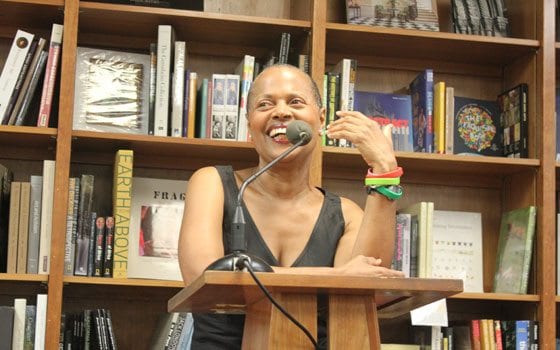
When audiences last saw her, Precious Jones, the unforgettable heroine of Sapphire’s 1995 novel “Push,” was a teenager recovering from years of abuse and trying to make a better life for her newborn son, Abdul. At the novel’s close, she tested positive for HIV, a virus she contracted through her father, but through literacy, found hope, a sense of self and an indomitable spirit.
Now, readers are invited into a new chapter in Precious’ family saga with the publication of Sapphire’s sequel, “The Kid.”
But readers hoping for more of Precious will be disappointed — this is an untraditional sequel that instead of re-entering the world of Sapphire’s original protagonist, breaks open the mind of her son Abdul.
“I felt like I had already effectively told the story of a young woman, who after suffering horrific abuse, recreates her life through language,” Sapphire explained on the opening leg of her book tour, in Washington, D.C. “The world had Precious’ story, it would not have been hard for me as a writer to stay in her head, I loved her so, but I knew it was time for me to move on. It was Abdul’s time.
“I found [Abdul] an ideal vehicle for showing how America doesn’t function for certain segments of society, particularly young African American males who ironically are then themselves classified as dysfunctional.”
“The Kid” opens at Precious’ funeral; she has died of AIDS at the age of 27. Abdul is just 9 years old, and with his mother’s death, is forced into a tough and often merciless world. He is sent to a foster home and then to a Catholic orphanage, and like his mother, encounters abuse at the hands of those who should be caring for him.
The novel, Sapphire explained, takes on issues of AIDS, single motherhood and adoption in the black community. Although Precious had been “a valiant single mother … the primary tragedy of single motherhood is [that] when she falls, he falls too.” With no family or “functional friends” to care for him, Abdul must look after himself, and immediately falls victim to various predators.
“Had Abdul been adopted when his mother died at the age of nine, we wouldn’t have had to write this book,” Sapphire continued. “The ugly secret, the well-kept secret is that a cat or a dog is more likely to be adopted than a dark-skinned African American male child. Anybody who’s involved in adoption efforts will let you know that the last to be asked for is black boys.”
But like his mother, Abdul finds redemption in the arts. When he is 13 years old, Abdul stumbles into an African dance class at a local gymnasium, and from then on is determined to become a dancer when he grows up.
“From the moment Precious dies, his primal connection is severed,” Sapphire said. “And it’s through the act of dance that he’s able to reconnect first with the earth and with the rhythm, and the force that his mother was … So it’s in the act of dancing that Abdul can literally take back his life and begin to empower himself.”
Abdul’s story also offers glimpses into his family’s roots. Although he remains largely unaware of his personal history — like the identity of his father and the way his mother contracted HIV — Abdul briefly encounters his great-grandmother, Toosie Johnston, who reveals painful details from her own past. He is repulsed by Toosie’s stories and at first cannot accept the fact that they are related, but, as Sapphire explained, “she will in some ways restore his sense of racial and maternal and primary connection with her story.”
Similar themes run through Sapphire’s two novels, but “The Kid” depicts a very different kind of protagonist than Precious Jones. Readers witness Abdul move through the entire cycle of abuse, from victim to victimizer, making empathy with him a more complicated task. Abdul’s struggle throughout the novel, then, becomes taking responsibility for his own actions and accepting that he is not simply a boy who has been wronged, but a man who has also wronged others.
To mirror the moral complexity of Abdul’s character, Sapphire’s writing style in “The Kid” is similarly complex. The reader is taken through Abdul’s many dream-like states, often with little clarity about the reality surrounding him.
Despite the differences in their characters, readers also see the distinct influence of Precious on her son. The first thing readers will notice is Abdul’s literacy. “At 9 years old, Precious has enabled Abdul to read better than she did at 18,” Sapphire explained. “So she’s provided a life for him where this boy can read better than her.”
But more importantly, Abdul is a fighter who believes he can achieve anything in this world, even if reality tells him otherwise.
“His mother has imbued in him — and we don’t know if it’s a lie or if it’s the truth — but she’s told him you can make it if you try,” Sapphire said. “You are somebody, you are my baby, and no matter what happens, you are somebody. So despite being disenfranchised and kind of kicked out of the culture in a certain way, he keeps trying to get back in.”






